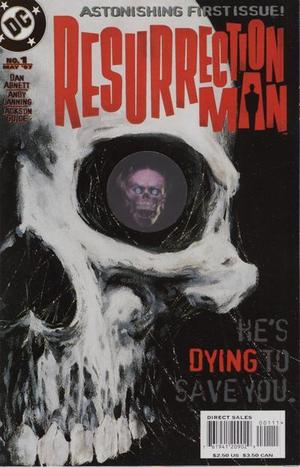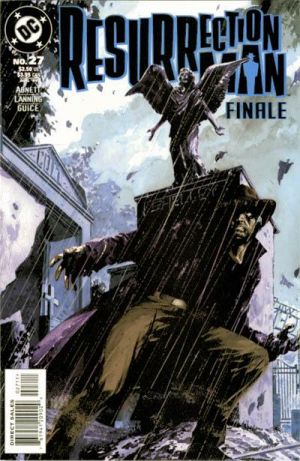Comics /
Back Issues
Back From the Dead: Abnett and Lanning’s Resurrection Man
By Josh Dean
September 17, 2011 - 14:39
This past week saw the release of Resurrection Man #1 (see Garth’s review at this very site) from DC as part of their new 52 initiative. Of all the concepts they are revitalizing, this is the one that made me the most curious. Nearly every other run that is being pushed out was either highly commercially viable at one time or was a critical darling. To my knowledge, Resurrection Man was neither.
Part of the mini-boom from DC in the 1990s, Resurrection Man joined titles like Chase, Chronos and Hourman on the pile that could be labeled “noble failures.” Dan Abnett and Andy Lanning (DnA) have gone on to create great works with Marvel’s cosmic universe and are slowly returning to DC this year (they did a couple of the Flashpoint tie-in series) but I had not heard of them when Resurrection Man was first released in early 1997. They were paired with Butch Guice, an old pro at comics like X-Factor, Dr. Strange and Action Comics, who is vaguely from the Neal Adams’ school of lean bodies and strong detail (not so much on his backgrounds). The concept was sort of a spin on the old Dial H for Hero idea. The first issue begins with Mitch Shelley (our hero) discovering he can fly. He is homeless, amnesiac and prone to getting into heroic situations. Within the first three pages, he flies between some gang bangers and their target, thus getting shot to bits and dying.
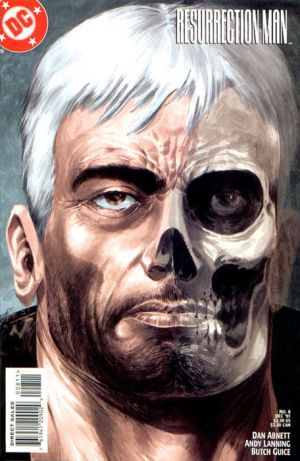 |
He wakes up in a morgue with a different super-power (I believe his next after the shooting was to create strong blasts of air) and his body intact. Over the course of the first arc, he discovers he is a lawyer from South Carolina who was supposedly killed in a gas explosion several years earlier. He quickly figures out that he can’t die and each time he is killed, he returns with a new power. Over the course of the series, Resurrection Man is shot, poisoned, decapitated, blown up and generally just abused harshly. There are a pair of hitwomen called The Body Doubles who are in pursuit of Shelley. A shady organization had been experimenting on him and they want him back. Shelley is also being followed by a man called Hooker who also can’t die but drains the life from others on his travels.
DnA really had fun playing with superhero conventions in this series. Because, of course, if you are just some schmuck with the power to fly or create hard air blasts, you are probably going to get shot to death within the first ten minutes of being a superhero. As the series progresses, Shelley gets slightly better at fighting but he is mostly only effective when he has some sort of power that gives him a physical edge (like super-strength or cosmic level power). Although not really touted as such, this is pretty much one of the few mainstream series to deal with the pitfalls of existing in a real, dangerous world with one special ability at a time.
Guest stars were used mainly to contrast the differences between Shelley and his fellow DC heroes. In issue 2, Shelley happens across a battle between the Justice League and Amazo. He has no way of helping them battle such a menace, so he assists with helping civilians out of the line of fire…and then dies. Likewise, in issue 7, Batman slowly realizes that the same man has been killed at three crimes scenes in one day and pieces together the existence of the Resurrection Man. Shelley’s entire career is pretty much one big heroic sacrifice. Later in the series, after gaining almost Superman level power, Shelley runs into the JLA again and actually helps them battle Major Force. His ineptitude as a hero endangers civilians and he quickly rethinks his career choice. The only guest star to really fit into Shelley's world is Garth Ennis' Hitman. Clearly, DnA have more on their mind than cliché superhero plots.
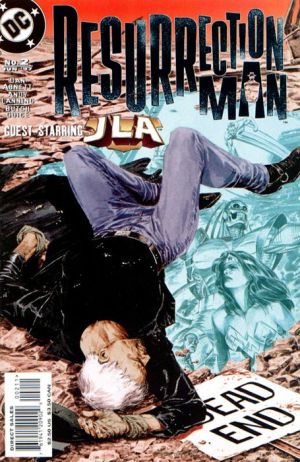 |
In one review I read of the relaunch, the reviewer stated that this title would work better as a movie than a series. I must disagree in that DnA use the medium better than almost any writer since Grant Morrison. To wit, Shelley is commonly dismembered and sometimes pulped (as in the relaunch) in the course of his heroism. With the magic of gutters, Shelley is restored to his full, healthy body between panels with no attempt at an explanation. In a movie, Shelley would have so fall off-screen in pieces and just leap back into frame whole unless a screenwriter wants to really get bogged down in the mechanics of the resurrections, which seems like grisly business.
Likewise, the entire series is very gritty (Guice draws everyone kind of scuzzy and sleazy, with unshaved faces and greasy hair) both visually and in the writing. One of the most bizarre aspects of the run was the apparent popularity of the Body Doubles. These two buxom women (strongly implied to have a Sapphic relationship) are amoral in the outset (murdering everyone at a homeless shelter to get at Shelley). Their growing popularity led to a New Year’s Evil one-shot and, after Resurrection Man was cancelled, a mini-series. DnA wrote them as increasingly sympathetic figures, which is why I imagine their popularity waned. The Lethal Protector genre of the anti-hero was hitting a peak by the late 1990s and I imagine their ruthlessness was their hook (I can’t imagine anyone finding Guice’s renditions of their ridiculous outfits sexy but perhaps that was a draw also). As they became less deadly, so too were they less interesting. Oddly, they never seemed to develop distinct personalities and were written pretty interchangeably (which makes me think DnA never meant for them to be more popular than the main character).
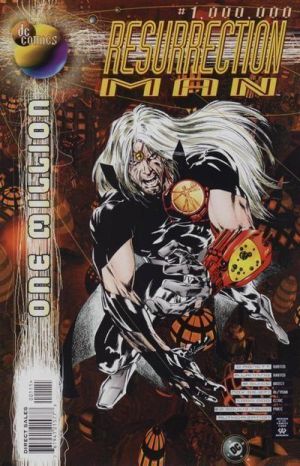 |
For all the graphic violence and the sex, the series read like a watered down Vertigo title. For instance, in one issue, Shelley runs afoul of the House of Secrets, Dead Man and the Phantom Stranger in the Dreaming. The title really did push the boundaries of mainstream comics in a mature direction while keeping one foot firmly in the DCU. Shelley played a major role in Grant Morrison’s DC 1,000,000 series and the title worked its way into the Genesis crossover as well. For all the promotion and guest stars, Resurrection Man (along with the angelic version of Supergirl, with which this title directly crossed over) failed to establish a viable non-Vertigo magical realm for the DCU. It all fell apart after 28 issues (out lasting Chase, Chronos and but not by much).
The last arc dangles the idea that Shelley is the old enemy of Vandal Savage, known as the Immortal Man. The Forgotten Heroes (including Vertigo mainstay Animal Man) guest star and DnA once again demonstrate their love and knowledge of the expanded universe by bringing new heroes into the ranks of the Forgotten. The final arc is really fun and surprising but it was too little, too late.
Guice’s art is a pretty divisive thing to behold. I, personally, was never sold on it but those who love it, really love it. DnA brought a very British sensibility to the writing (lots of Morrison’s Big Ideas and love of continuity along with a 2000 AD style of irreverence) that presents a unique read but is not entirely satisfying. Were the series to have run for five years, the gradual teasing out of Shelley’s origins and his purpose for existing as a character would have (no doubt) become clearer. As it was, the reader never had a chance to really figure out why this scumbag mob lawyer decides to start helping people after he is betrayed and experimented on. With unclear motives and goals, the whole series kind of meanders episodically so that the whole is less than the sum of its very entertaining parts.
With the new #1, it looks like we might get some more insight into the character’s true nature as well as continue the idea that he is a part of the dark, magic side of the DCU. I will refrain from judgment until some more issues come out but I fear that this entire concept may be more appealing in the abstract than in practice.
Last Updated: January 17, 2025 - 08:20
